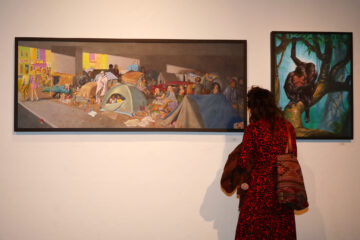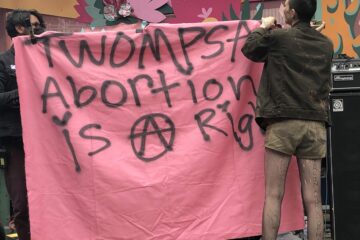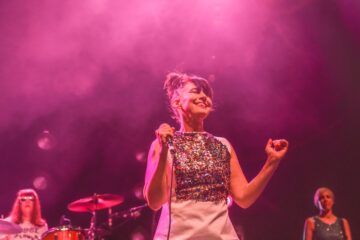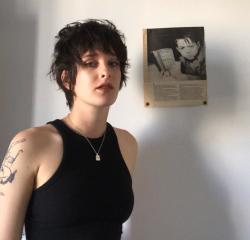Local Writers Honor the Life of SF Chronicle Cartoonist Don Asmussen

Late cartoonist Don Asmussen and author Mary Ladd posed with a poster for their humorous book about weathering cancer, then called “The Wig Report,” at Ladd’s “Nipple Release Party” celebrating her new nipples on Jan. 17, 2018, at the Make Out Room in San Francisco. (Photo courtesy Ted Weinstein)
If you’ve cracked a copy of the San Francisco Chronicle in the last 20 years, you’ve probably been graced by the sharp wit of Don Asmussen.
Asmussen’s comics were featured in Time and The New Yorker before he was hired by the San Francisco Examiner editor Phil Bronstein in 1995. Bronstein proved especially supportive of Asmussen, encouraging him to “push boundaries and take on powerful figures in the San Francisco Comic Strip.” Apparently, this was all the encouragement he needed. Asmussen’s style took on an increasingly subversive edge in his critiques of politicians and public figures, often featured in his San Francisco Chronicle strip, “Bad Reporter.”
Asmussen’s “Bad Reporter” comic emerged shortly after the Examiner merged with the Chronicle in 2000. Delightfully deranged, Asmussen’s biweekly, syndicated strip mined culture and politics for “the lies behind the truth, and the truth behind those lies that are behind that truth.” This was where Asmussen found his stride, garnering a devoted readership. His deft use of satire and absurdity was entirely his own.
In 2019, Asmussen publicly announced that he had been diagnosed with brain cancer. Following this announcement, he illustrated “The Wig Diaries: An Irreverent Cancer Book” with writer and friend Mary Ladd.

An early version of Asmussen’s cover art for “The Wig Diaries: An Irreverent Cancer Book” — then titled “The Wig Report” — was featured at Mary Ladd’s “Nipple Release Party” on Jan. 17, 2018. (Photo courtesy Ted Weinstein)
“He was the only person to email me something that made me scream with laughter when I told friends over email that I had cancer,” Ladd said. “There was a connection in facing our mortality and using humor to get through it. He seemed to think that we’d be crying if we weren’t laughing, which is true.”
On Dec. 9, Asmussen died at age 59. Before he passed, he dictated his own obituary, in which he honored his wife, Kelly Zito, and his two daughters, Maxine and Tessa.
Although our meeting was brief, I can attest to the rare warmth and humor that Asmussen so readily shared with everyone. In honor of his memory, I invited several of his friends and co-workers to reflect on their time with him.

Late cartoonist Don Asmussen and author Mary Ladd at Ladd’s “Nipple Release Party” on Jan. 17, 2018, at the Make Out Room in San Francisco. (Photo courtesy Ted Weinstein)
How did you meet Don Asmussen?
Leah Garchik (San Francisco Chronicle features columnist): “At the office, after the two newspapers merged. I had much loved the work he did at the Examiner, and was so pleased to be able to work on the same side as he was.”
Mary Ladd (author and journalist): “Via the SF Chronicle. My husband, Oscar Villalon, worked there for years, and I got my writing start at the food section there. We also hung out at a lot of Litquake events with friends of (Litquake cofounder) Jane Ganahl, which led to us attending events where Don was on a panel or talking about his work.”
Andrew Farago (Cartoon Art Museum curator): “I met Don over email in the early 2000s, not long after I started working at the Cartoon Art Museum. He was always quick to lend a hand if I needed help with an exhibition, whether it was friendly advice, opening up his address book or lending artwork. Our in-person interactions were few and far between, sadly, but most of our interactions over the years were through email and phone calls, so the times that I did get to hang out with him stand out even more now.
“He wasn’t a big self-promoter, but if a friend had a new book or project, or if he could show his support for a local nonprofit, he was there. The only time I can remember that he was willing to be the center of attention at the Cartoon Art Museum was during a Litquake event in 2019, and even that was because he wanted to talk up Mary Ladd’s writing in their book, The Wig Diaries.”
Jack Boulware (writer and cofounder of Litquake): “I didn’t know Don all that well, but we laughed a lot every time we were in the same room together. I met him first in early 1999, in the office of Phil Bronstein, who was then editor of the SF Examiner. We were having a meeting to discuss our idea of launching a literary festival, which was called Litstock (In 2002, the name was changed to Litquake). Jane Ganahl is my cofounder, and she worked at the Examiner at the time, and pitched the notion to Phil [Bronstein] for the Examiner to sponsor this harebrained idea of a bunch of writers reading their work at Golden Gate Park’s bandshell. Phil had already agreed, and so this meeting was just about hashing out some details. Don was there because, as an employee of the Examiner, he would be designing the festival poster as part of his job.
“He looked fairly normal, but I was already aware of his comics and his demented sensibility (I was editor of the satirical Nose Magazine in the ’90s, and the editors were big fans of Don’s stuff). I remember thinking, ‘Oh cool, if Don’s doing the graphics, it’s going to be pretty unique.’ Jane and I gave him the basic info, date and time, author names, and he turned in the artwork, and it was just hilarious. Spot-on. The following year, he did another poster for us, and both have hung on the walls of every office we’ve had in the city. That tone of irreverence still runs through the DNA of our festival, and is a reminder for all of us to never take it too seriously.

1999 festival poster for Litstock, the precursor to Litquake, by Don Asmussen. (Photos courtesy Jack Boulware)
“He appeared in several Litquake events over the years, and was always very sharp-witted, another in a long line of great Bay Area humorists. Here’s a clip of Don and other cartoonists, at one of our events at SF Public Library, reacting to the 2016 election.”
What quality of Don’s did you most admire in him? How did he inspire you?
Leah Garchik: “His absolute fearlessness. He was writing about local issues and people, and always took aim without flinching. But his dry wit was so engaging that I think even his targets, (Bronstein and the dragon, for example), didn’t seem to mind. I totally envied his ability not to worry about annoying anybody; that’s real journalism. And he often made me laugh out loud. I think LOL is too easy a symbol to express the meaning of “laughing out loud.” There you are, reading a two-dimensional strip — ink on paper — and it inspires emotion, physical reaction, heaving of the shoulders, giggling. That’s a process that’s always amazed me, and Don’s work elicited that reaction in so many of his fervid readers, including me.”
Mary Ladd: “For someone so incredibly talented, there was zero tolerance for ego or B.S. He inspired me because I often got a fresh take on an issue or public individual from his strips. It was also exciting to realize it’s OK to push boundaries and say things that are controversial but true — as an artist and also as a cancer patient. Don did not want to be a cancer hero to anyone, and that made me dig deeper on how to interact with the world with that in mind.”

“The Four Stages of Pitching a Cancer Book” comic strip for “The Wig Diaries: An Irreverent Cancer Book” by Mary Ladd. (Courtesy Mary Ladd)
John McMurtrie (writer, former books editor at the San Francisco Chronicle): “Don’s cartoons were highly imaginative — satirical and silly and sometimes biting. But he didn’t just toss them off. I worked in the same room with him for years, and I always admired how devoted he was to his craft, putting in long hours to perfect his art. If you didn’t know him well, you’d think he was intimidating — his furrowed brow and intense gaze suggested he didn’t have time for you, or didn’t suffer fools. In truth, though, he was a generous soul: Once you got to talking to him, he’d quickly lighten up. He was easygoing and affable and liked to laugh, and anyone around him was taken in by his exuberance. We were all lucky to be in his presence.”
Andrew Farago: “I loved reading Don’s comics every week, and ‘Bad Reporter’ never failed to crack me up. Whether it was local politics or international celebrities, he managed to surprise me every time I read his comics. On the rare occasions, he went for an obvious joke, he’d find an oddball way to get to that punchline. No matter what else was happening in the news, you could count on Don to make you laugh.
“Don’s bravery in the face of his illness was truly inspirational. My wife and I ran into him in a coffee shop in Berkeley a few years ago, when she noticed his sketchbook and leaned over to tell me, ‘Hey, that’s Don Asmussen,’ and we chatted with him about comics, upcoming projects and he just casually mentioned that he was working on a book about cancer with his friend, Mary.
“Upbeat, positive, supportive and dedicated to his art, that’s how I’ll remember him.”
Regan McMahon (former books editor at the San Francisco Chronicle): “He was one of the funniest people I ever met, but in a truly brilliant, clever, deadpan witty way, not a class clown jokey way. I mainly admired him from afar — meaning my breakfast table in Oakland, where my husband and I would relish his ‘Bad Reporter’ strips, usually reading them aloud to each other. As an editor, I loved his trenchant political insights, zeroing in on the most absurd yet truest aspects of a political moment or scandal. And I loved his versatility in not only creating within the comic strip format, but also providing caricatures and illustrations beyond the scope of his strip.”

A graphic for the 2000 festival poster for Litstock, the precursor to Litquake, by Don Asmussen. (Photo courtesy Jack Boulware)
Can you share your favorite memory with Don?
Leah Garchik: “In person, his impishness had a kind of wholesome quality. Laughing together was wonderful, as well as sharing bitches about office bureaucracy. That’s what makes a colleague close, being able to appreciate the glory of getting your say in public, and acknowledge how much that means to each of you, but also commiserating about the day to day stuff that can be so annoying. I remember Don talking with a group of students I had invited to tour the office. Steve Rubenstein, Kevin Fagan and Don took time out to talk to them, Don drawing a cartoon while they watched, goggle-eyed. I was so proud of my colleagues and their teamwork and to share parts of themselves with these kids, who were about 8 years old.
“I can’t express how sad I am that brilliant, funny, mordant Don is gone.”
Mary Ladd: “One Sunday night after a big Ferry Building group dinner led by Jane Ganahl, Oscar and I piled into a cab with Don, author Thomas Sanchez, and the American conceptual artist and experimental philosopher Jonathon Keats, and ended up at the Mission apartment Oscar and I shared. We were in awe of Thomas and his work, but no punches were pulled. A toast was made to Thomas, and we talked about art, literature, writing, life, history, food, sex late into the night. It felt like a more vivid and less subdued My Dinner with Andre.
“Another favorite memory was getting lunch at Buena Vista Cafe with you, Philip Walker and Don after touring the Cartoon Art Museum. It was a longer lunch and felt extravagant for a weekday — so many minutes away from work and stress and screens. He was in pain, yet able to enjoy some local seafood.”
Regan McMahon: “I was thrilled to engage with his illustrations for Mary Ladd’s The Wig Diaries, her brutally honest and hilarious book, which I edited, about dealing with cancer and recovery. And to get to chat with him at their book events and readings, where he was always the funniest guy in the room, as well as one of the nicest and warmest and easiest to talk to. I was moved by his candor in talking about his own battle with cancer, which I think being part of that book launch gave him a freedom to do. I took a photo of Mary and Don next to a blow-up of the book cover at an event at a bar in the Mission, and they were smiling like proud parents, even though the book wasn’t out yet. It was a joyous night.”









